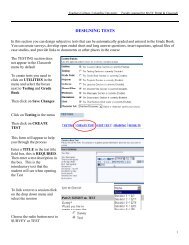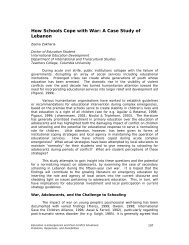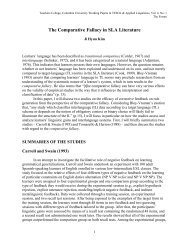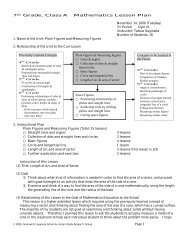UNICEF Mongolia - Teachers College Columbia University
UNICEF Mongolia - Teachers College Columbia University
UNICEF Mongolia - Teachers College Columbia University
You also want an ePaper? Increase the reach of your titles
YUMPU automatically turns print PDFs into web optimized ePapers that Google loves.
CHAPTER 4: THE IMPLEMENTATION OF THE 2007 SALARY REFORM AT SCHOOL LEVEL<br />
load of 646 hours is extremely low. The average for OECD countries is 779 hours per year in primary<br />
school, 701 hours in lower secondary school, and 656 in upper secondary school. 29 It is important to<br />
note that there is no direct relaon between educaonal quality and statutory teaching load of teachers.<br />
For example, Finland (league leader in PISA 2002) prescribes an annual statutory teaching load of 677<br />
hours for primary teachers, 592 for lower secondary teachers, and 550 for upper secondary teachers. In<br />
contrast, the statutory teaching load of teachers in the United States is on the other end of the extreme,<br />
as they are required to teach 28-30 hours per week, or annually slightly over 1,000 hours.<br />
In pracce, seventy percent of teachers in <strong>Mongolia</strong> average 697 paid hours per year rather than the<br />
statutory teaching load of 646 hours. Thus, the proposion to increase the statutory teaching hours<br />
for teachers in <strong>Mongolia</strong> is related to the school curriculum (mainly in primary school), and would be a<br />
maer of adjusng the regulaon to reflect the current pracce in schools.<br />
4.2. A MORE PREDICTABLE AND TRANSPARENT INCOME<br />
There were three features of the previous salary structure (pre-2007 salary reform) that made the<br />
teacher salary unpredictable and non-transparent:<br />
• Fragmentaon<br />
• Deducons from salary supplements<br />
• Bonus system<br />
These elements will be addressed in the following secons.<br />
4.2.1. Fragmentation<br />
Back in 2005, teachers and educaon managers who were interviewed in the PETS <strong>Mongolia</strong> study<br />
were not able to specify how much money they were making for the past or current month because<br />
the salary was fragmented and the extent of supplement deducons was unpredictable. At present,<br />
the salary structure is slightly less fragmented than in 2005. There are several components that make<br />
up the salary of a teacher in <strong>Mongolia</strong> in 2012. The following list and Figure 14 illustrate the various<br />
components of today’s salary structure:<br />
• Base salary (5 salary categories, determined by years of experience)<br />
• Addional teaching hours<br />
• Supplements for funcons:<br />
o class teacher<br />
o cabinet<br />
o head of secon<br />
• Supplement for rank (lead teacher, methodologist, advisor)<br />
• Bonuses for performance:<br />
o Quarterly allowance (A, B, C)<br />
o Outcomes-based addion/bonus<br />
o Olympiads, compeon<br />
• Benefits for public servants/teachers (from central budget and local budget)<br />
1<br />
2<br />
3<br />
4<br />
5<br />
6<br />
TEACHERS IN MONGOLIA: AN EMPIRICAL STUDY ON RECRUITMENT INTO TEACHING,<br />
PROFESSIONAL DEVELOPMENT, AND RETENTION OF TEACHERS<br />
63<br />
29 See OECD. (2001). Educaon at a Glance: OECD Indicators. Paris: OECD (see indicator D4, p. 422 ff.).














![TC Tod[...].pdf - Teachers College Columbia University](https://img.yumpu.com/27074883/1/190x252/tc-todpdf-teachers-college-columbia-university.jpg?quality=85)


